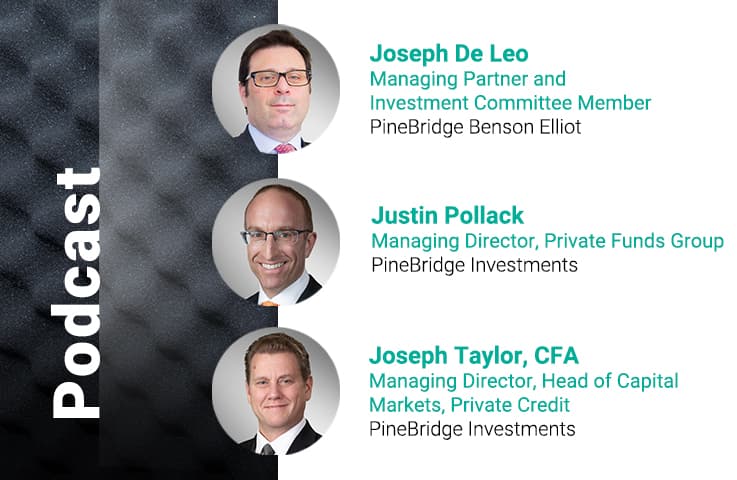Private Equity Trends: Investors Overallocated to Illiquid Assets Face the ‘Denominator Effect’ – But Here’s Some Good News

Justin Pollack
Managing Director, Private Funds Group

Investors are still trying to reconcile how all asset classes declined during 2022, with everything from US government bonds perceived to be the least risky through emerging market equity performing poorly (see chart). While this trend extended to other distinct strategies, such as real estate, private equity has thus far been something of an outlier: According to Preqin,1 private equity asset values fell just 4.5% from 1 January 2022 through 31 December 2022, versus 19.8% for global public equity as measured by the FTSE All World Index.
Asset Class Performance
1 January 2022 - 31 December 2022

Source: FactSet data including FTSE All World UCITS (equity); FTSE World Global Index (government bonds); Markit iBoxx USD Liquid Investment Grade Index (investment grade credit); Bloomberg U.S. Treasury Inflation Protected Securities (TIPS) Index (inflation-linked bonds); Markit iBoxx Global Developed Markets Liquid High Yield Capped Index (high yield bonds); JPMorgan EMBI Global Core Index (emerging market debt); FTSE EPRA Nareit Global REITS Net Total Return Index (real estate); Preqin Private Capital Quarterly Index; and LBMA Gold Price (gold). Private equity index from Preqin not available during this time period.
Yet, given the big losses in public equities, investors are understandably asking private equity managers how they can justify these valuations. Since private equity transactions typically use more leverage than publicly traded companies, the effect of declining valuations should be considerably negative. Notably, all private capital provided a slightly negative return of 0.5%2 over this timespan due to strong unrealized gains for real estate and infrastructure investments, despite rising interest rates that heavily cut the values of similar assets held in publicly trade vehicles.
For the past two decades, institutional investors increasingly took advantage of the strong performance of private equity to enhance total portfolio returns. Yet the consequences of this shift during a bear market are now becoming apparent: Following the decline by all liquid asset classes, the deliberate way that financial sponsors value private assets has created the appearance of a dramatic overweighting of private holdings versus other assets. Solving this “denominator effect” may require disruptive actions, such as sharply reducing new investment activity or correcting an imbalance immediately via secondary sales. Yet as we explain, there are upsides to this dynamic that investors can potentially take advantage of.
Rising alternative asset allocations have created their own issues
Public equities once dominated institutional portfolios, with the majority of allocations going to this liquid asset class in the early 2000s. That share fell dramatically in the aftermath of the global financial crisis (2008-2009) and has not returned to previous peaks. Meanwhile, institutional investors increasingly embraced alternative assets, which grew steadily from 6% of global portfolio allocations in 2000 to 11% in 2021 (see chart). Yet the increase in weighting of illiquid assets creates its own problems during a time when asset allocations are askew.
Alternatives Are Now a Larger Part of Asset Allocation
Institutional Portfolio Allocations

Source: State Street Global Advisors, Global Market Portfolio: Value of Investable Assets Touches All-Time High (February 2022).
Private equity firms’ mark-to-market policies provide wide leeway in how to handle a sudden market dislocation. As the global financial crisis unfolded starting in early 2008, private equity firms wrote down their portfolios at half the rate of the drop in the public markets; however, the subsequent recovery in book values was much slower than the climb in public stocks that started in the second quarter of 2009 (see chart). Institutional investors likely expect a repeat of this smoothing of returns in 2023, which would create an imbalance between private market holdings and liquid assets.
Financial Crisis Performance of Public vs. Private Equity Offers Lessons for Today

Source: Preqin database as of 31 December 2022 including MSCI World TR (public equity) and Preqin Private Capital Quarterly Index (private equity).
The ‘denominator effect’ and its consequences
The result of this imbalance is that the majority of institutions are now overcommitted to private equity (see chart). That marks a significant change from the end of 2021. But rather than celebrate the apparent outperformance of PE, most institutions know this may just be delaying the pain. This result, which we also witnessed in the aftermath in 2008-2009, is the dreaded “denominator effect” – when the amount of private assets (the numerator) remains static while total assets (the denominator) shrink considerably. Patient investors can correct these proportions as private assets decline or liquid assets rebound, but the time horizon required is tough to predict. And policies at many institutions require rebalancing, which generally cannot be accomplished quickly or easily.
More Institutional Investors Are Now Overallocated to Private Equity

Source: “The Trillion Dollar Opportunity in Private Equity Secondaries,” Overbay (October 2022).
Solving an overallocation problem often leads investors to immediately reconsider any new private asset commitments, with the reasoning that taking advantage of new investment opportunities, regardless of their merit, would only add to the problem. A 12% decline in global private equity fundraising in 2022 provides early evidence of this change in behavior. Much of that decline came in the second half of 2022, when institutions started to recognize the dilemma of being overweight in this asset class.
Moving the goalposts
For all sorts of pensions, financial institutions, sovereign wealth funds, and family offices, the weight of an allocation to private equity is typically dictated by internal policies, not a limit imposed by regulation. The easiest way to solve an overallocation is to raise the target so that an existing portfolio fits within the guidelines. A survey of senior executives at institutions who invest in private markets showed that an astounding 43% intended to make a substantive increase in their private equity allocation in 2023.3 This was followed by 29% who intended to make a small increase.
With 72% of institutional investors pivoting toward more private equity, it is less a sign of growing interest in the asset class than it is a recognition that prior commitments became outsized when other portfolio asset values dropped sharply in 2022. After pausing new commitments, changing allocation targets is the second step an institution is likely to take to get back into balance. This ignores more dynamic portfolio management that tends to be the domain of sophisticated investors.
Complicating matters
Investors may be hesitant to stop commitments completely, so many focus their activity on renewing existing relationships. An approach of this sort favors familiarity over efficacy, which can lead to lower portfolio returns. Meanwhile, managers without a base of institutional support, particularly those that are raising capital for the first time, are expected to face a higher hurdle to success. Even firms with a compelling prior track record may find that their investing partners who generally are not afraid of first-time managers are shy for fear that other institutions won’t invest, thus leaving a sub-scale pool of capital. Yet the reticence of investors to change course potentially creates a distinct opening for institutions who are willing to fill in this gap.
Global Private Equity Fundraising Has Dropped

Source: Preqin database as of 31 December 2022.
Numerous institutions are taking a more proactive approach to overallocations by resetting their holdings. Secondary sales rose by 11% in 2022, led by a sharp rise in the sale of LP fund positions. Jefferies found that 50% of the sellers had never accessed the secondary markets previously.4 This marked a doubling in the number of first-time sellers from 2021. Portfolio management is a common reason to seek liquidity in this fashion, but it may be the best path for institutions to quickly correct an overweight in private equity. Secondary buyers were happy to accommodate the rise in volume, but it came with a corresponding decrease in payments, as Jefferies found transactions occurred at price discounts more than 1,000 basis points greater than in the prior year.
Secondary Market Transaction Volumes Were Up in 2022

Source: Jefferies Global Secondary Market Review (January 2023).
Going forward
Solving for the denominator effect may cause some institutions to take disruptive actions such as sharply reducing new investment activity or correcting an imbalance immediately via secondary sales. Market participants may see an attractive window to seize two distinct opportunities resulting from this change in institutional behavior. Large investors who are allocating less capital than in the past are likely to focus on their most important and enduring manager relationships. This potentially introduces a new challenge for firms who depend on a narrow set of investors, have a niche focus, or who have yet to recruit institutional investors. Investors who do not overlook the potential for attractive performance among these managers may be able to use their scarce capital to drive larger economic discounts.
Meanwhile, institutions eager to quickly correct an overallocation through an outright sale of non-core assets are confident that the secondary market has expanded and grown to feature numerous potential liquidation options.
The private equity landscape has remained dynamic enough to adjust to the changing conditions, albeit the beneficiaries of the rise of the denominator effect may not necessarily be those who are stuck with this problem.
Disclosure
Investing involves risk, including possible loss of principal. The information presented herein is for illustrative purposes only and should not be considered reflective of any particular security, strategy, or investment product. It represents a general assessment of the markets at a specific time and is not a guarantee of future performance results or market movement. This material does not constitute investment, financial, legal, tax, or other advice; investment research or a product of any research department; an offer to sell, or the solicitation of an offer to purchase any security or interest in a fund; or a recommendation for any investment product or strategy. PineBridge Investments is not soliciting or recommending any action based on information in this document. Any opinions, projections, or forward-looking statements expressed herein are solely those of the author, may differ from the views or opinions expressed by other areas of PineBridge Investments, and are only for general informational purposes as of the date indicated. Views may be based on third-party data that has not been independently verified. PineBridge Investments does not approve of or endorse any republication of this material. You are solely responsible for deciding whether any investment product or strategy is appropriate for you based upon your investment goals, financial situation and tolerance for risk.


